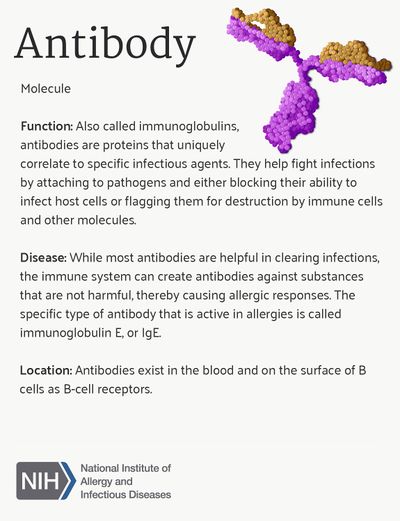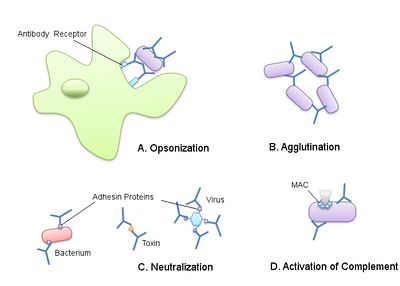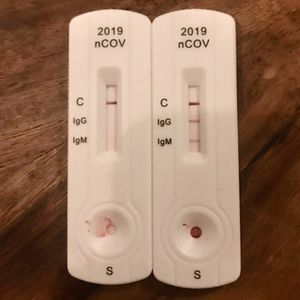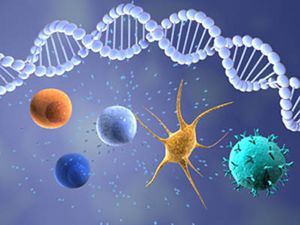Immunoglobulins (Ig): Difference between revisions
No edit summary |
m (Introduction, punctuation corrections, clinical use) |
||
| Line 14: | Line 14: | ||
Immunoglobulins (Ig) or Antibodies: Glycoproteins that your immune cells make to fight off [[Bacterial Infections|bacteria]], [[Viral Infections|viruses]], [[Fungal Diseases|fungi]], [[Parasitic Infections|parasites]], cellular antigens, chemicals, and synthetic substances. Plasma cells (AKA plasma B cells) are the key cells involved in humoral immunity and produce immunoglobulins. B cells are instructed by specific immunogens, for, example, bacterial proteins, to differentiate into plasma cells, which are protein-making cells that participate in humoral [[Immune System|immune]] responses. | Immunoglobulins (Ig) or Antibodies: Glycoproteins that your immune cells make to fight off [[Bacterial Infections|bacteria]], [[Viral Infections|viruses]], [[Fungal Diseases|fungi]], [[Parasitic Infections|parasites]], cellular antigens, chemicals, and synthetic substances. Plasma cells (AKA plasma B cells) are the key cells involved in humoral immunity and produce immunoglobulins. B cells are instructed by specific immunogens, for, example, bacterial proteins, to differentiate into plasma cells, which are protein-making cells that participate in humoral [[Immune System|immune]] responses. | ||
* Immunoglobulins constitute about 20% of the protein in plasma<ref name=":1">Vaillant AA, Ramphul K. [https://www.ncbi.nlm.nih.gov/books/NBK513460/ Immunoglobulin]. InStatPearls [Internet] 2019 Nov 10. StatPearls Publishing.Available from:https://www.ncbi.nlm.nih.gov/books/NBK513460/ (last accessed 3.12.2020)</ref> | * Immunoglobulins constitute about 20% of the protein in plasma<ref name=":1">Vaillant AA, Ramphul K. [https://www.ncbi.nlm.nih.gov/books/NBK513460/ Immunoglobulin]. InStatPearls [Internet] 2019 Nov 10. StatPearls Publishing.Available from:https://www.ncbi.nlm.nih.gov/books/NBK513460/ (last accessed 3.12.2020)</ref> | ||
* They act as a critical part of the immune response by | * They act as a critical part of the immune response by playing three critical roles- They neutralize foreign materials through direct binding. They alter antigens so that they are more readily engulfed by phagocytes (opsonization). Lastly they recruit immune effector cells and trigger the release of cytokines and chemokines to destroy foreign antigens.<ref name=":2">Rose ME, Lang DM. Evaluating and managing hypogammaglobulinemia. Cleveland Clinic Journal of Medicine. 2006;73:133-142</ref> | ||
* The antibody immune response is highly complex and exceedingly specific. | * The antibody immune response is highly complex and exceedingly specific. | ||
* Antibody tests are used to detect disease-specific antibodies in a [[Blood Tests|blood sample]].<ref>Thermofischer scientific [https://www.thermofisher.com/au/en/home/life-science/antibodies/antibodies-learning-center/antibodies-resource-library/antibody-methods/introduction-immunoglobulins.html Immunoglobulins] Available from:https://www.thermofisher.com/au/en/home/life-science/antibodies/antibodies-learning-center/antibodies-resource-library/antibody-methods/introduction-immunoglobulins.html (last accessed 3.12.2020)</ref>. | * Antibody tests are used to detect disease-specific antibodies in a [[Blood Tests|blood sample]].<ref>Thermofischer scientific [https://www.thermofisher.com/au/en/home/life-science/antibodies/antibodies-learning-center/antibodies-resource-library/antibody-methods/introduction-immunoglobulins.html Immunoglobulins] Available from:https://www.thermofisher.com/au/en/home/life-science/antibodies/antibodies-learning-center/antibodies-resource-library/antibody-methods/introduction-immunoglobulins.html (last accessed 3.12.2020)</ref>. | ||
* WHO officially coined | * WHO officially coined the term Immunoglobulins for antibodies in 1964. <ref>Easybiology [https://www.easybiologyclass.com/difference-between-antibody-and-immunoglobulin/ antibodies] Available from: https://www.easybiologyclass.com/difference-between-antibody-and-immunoglobulin/ (last accessed 3.12.2020)</ref> | ||
* A low level of any or all of the immunoglobulins is called hypogammaglobulinemia. This is further divided into primary hypogammaglobulinemia (no known cause) and secondary hypogammaglobulinemia which can be divided into diseases of immunogloblin loss, diseases of immunoglobulin production, drug-induced states and high stress states <ref name=":2" /> | |||
== 5 types of immunoglobulins in humans == | == 5 types of immunoglobulins in humans == | ||
| Line 48: | Line 49: | ||
* Accounts for only around 0.25% of antibodies in the human body. | * Accounts for only around 0.25% of antibodies in the human body. | ||
* Important in the early stages of the immune response. | * Important in the early stages of the immune response. | ||
* Unlike other antibodies, it does not actively circulate but binds to B cells to instigate the immune response. As a signaling antibody | * Unlike other antibodies, it does not actively circulate but binds to B cells to instigate the immune response. As a signaling antibody. | ||
* IgD helps incite the release of front-line IgM to fight disease and infection. | * IgD helps incite the release of front-line IgM to fight disease and infection. | ||
* The least understood antibody, with little known about how it might participate in other parts of the immune system<ref name=":0">Very well health [https://www.verywellhealth.com/antibody-isotypes-3132614 Antibodies] Available from:https://www.verywellhealth.com/antibody-isotypes-3132614 (last accessed 3.12.2020)</ref> | * The least understood antibody, with little known about how it might participate in other parts of the immune system<ref name=":0">Very well health [https://www.verywellhealth.com/antibody-isotypes-3132614 Antibodies] Available from:https://www.verywellhealth.com/antibody-isotypes-3132614 (last accessed 3.12.2020)</ref> | ||
| Line 72: | Line 73: | ||
== Clinical use of immunoglobulins == | == Clinical use of immunoglobulins == | ||
[[File:Micro-Inmunotherapy.jpg|alt=|thumb|Micro-Inmunotherapy]] | [[File:Micro-Inmunotherapy.jpg|alt=|thumb|Micro-Inmunotherapy]] | ||
Immunoglobulin therapy is used worldwide and can be used in the areas of Neurology, Haematology, Immunology and other fields of medicine. | |||
* They are prepared from a pool of blood donated at blood collection centers and processed through fractionation to separate the protein fraction from the cellular component. | |||
* Polyvalent immunoglobin, derived from pooled human plasma, can be administered via the intravenous, subcutaneous or intramuscular route <ref>Peter JG, Heckmann JM. Recommendations for the use of immunoglobulin therapy for immunomodulation and antibody replacement. South African Medical Journal 2014;104:7306</ref> · It is prepared from a pool of blood donated at blood collection centers and processed through fractionation to separate the protein fraction from the cellular component · Immunoglobulin therapy is the mainstay of treatment for antibody-deficient disorders, as well as being an important supportive treatment for other forms of PI (1) · Antibiotics and antifungal treatments are also used to help prevent the frequency and severity of infections · Modern advances in fractition and filtration techniques since the late 1940s have led to safer and pure immunoglobulin preparations · Treatment is expensive and can be a barrier to timely and regular treatment in many countries. Furthermore, the choice of product options is limited in many countries, such as South Africa where only 4 different products are available (4)They are prepared from a pool of blood donated at blood collection centers and processed through fractionation to separate the protein fraction from the cellular component. | |||
* The purified immunoglobulin can be used in the treatment of many immunological problems, including antibody deficiencies, severe combined immunodeficiency disorders (SCID), multiple sclerosis, myasthenia gravis, Kawasaki disease, systemic lupus erythematosus (SLE), organ transplantations, and many others<ref name=":1" /> | * The purified immunoglobulin can be used in the treatment of many immunological problems, including antibody deficiencies, severe combined immunodeficiency disorders (SCID), multiple sclerosis, myasthenia gravis, Kawasaki disease, systemic lupus erythematosus (SLE), organ transplantations, and many others<ref name=":1" /> | ||
Revision as of 21:51, 15 April 2023
Original Editor - Lucinda hampton
Top Contributors - Kirsten Coutts, Lucinda hampton, Kim Jackson and Nupur Smit Shah
This article is currently under review and may not be up to date. Please come back soon to see the finished work! (15/04/2023)
Introduction[edit | edit source]
Immunoglobulins (Ig) or Antibodies: Glycoproteins that your immune cells make to fight off bacteria, viruses, fungi, parasites, cellular antigens, chemicals, and synthetic substances. Plasma cells (AKA plasma B cells) are the key cells involved in humoral immunity and produce immunoglobulins. B cells are instructed by specific immunogens, for, example, bacterial proteins, to differentiate into plasma cells, which are protein-making cells that participate in humoral immune responses.
- Immunoglobulins constitute about 20% of the protein in plasma[1]
- They act as a critical part of the immune response by playing three critical roles- They neutralize foreign materials through direct binding. They alter antigens so that they are more readily engulfed by phagocytes (opsonization). Lastly they recruit immune effector cells and trigger the release of cytokines and chemokines to destroy foreign antigens.[2]
- The antibody immune response is highly complex and exceedingly specific.
- Antibody tests are used to detect disease-specific antibodies in a blood sample.[3].
- WHO officially coined the term Immunoglobulins for antibodies in 1964. [4]
- A low level of any or all of the immunoglobulins is called hypogammaglobulinemia. This is further divided into primary hypogammaglobulinemia (no known cause) and secondary hypogammaglobulinemia which can be divided into diseases of immunogloblin loss, diseases of immunoglobulin production, drug-induced states and high stress states [2]
5 types of immunoglobulins in humans[edit | edit source]
Though the general structure of all antibodies is very similar, that small region at the tip of the protein is extremely variable. This allows millions of antibodies with different tip structures to exist. Each of these variants can bind to a different antigen. This enormous diversity of antibodies allows the immune system to recognize an equally wide variety of antigens
There are five main types of immunoglobulins, each immunoglobulin can have a different binding site that matches a specific antigen.
Immunoglobulin G (IgG)
- Accounts for around 75% of all antibodies in the human body.
- Depending on the antigen, IgG can either tag a pathogen so other immune cells and proteins will recognize it, or it can promote the release of toxins to directly destroy the microorganism.
- IgG can sometimes trigger an undesirable response in people with autoimmune disorders.
Immunoglobulin A (IgA)
- Accounts for 15% of all antibodies in the human body
- Primarily found in mucosal tissues (eg mouth, vagina, and intestines) as well as in saliva, tears, and breast milk.
- Produced by B cells and secreted from the lamina propria (a thin layer within mucosal tissues).
- One of the body's first-line defenses against infection - it binds to pathogens tagging them for destruction and preventing them from sticking to the epithelium (which lines the body's tissues).
- Associated with hypersensitive reactions in people with celiac disease and several other autoimmune disorders.
Immunoglobulin M (IgM)
- Immunoglobulin M (IgM) is also one of the first antibodies recruited by the immune system to fight infection.
- IgM populations rise very quickly when the body is first confronted with an infectious organism, and then they plummet as IgG antibodies take over.
- IgM is also produced by B cells and, when bound to a pathogen, will spur other antibodies and immune cells into action.
- A subset of IgM helps B cells "remember" a pathogen after it has been destroyed. If you were to become re-exposed to the pathogen later, your immune system should respond more quickly due to your memory B cells.
Immunoglobulin E (IgE)
- The antibody responsible for the allergic response that is mostly found in the lungs, skin, and mucosal membranes.
- Produced by B cells secreted by lymph nodes or other lymphoid tissues situated near the site of the allergen.
- When IgE binds to an allergen, it triggers a cascade of events. Basophils and mast cells (subtypes of WBCs,) degranulate and release histamine, an inflammatory compound, into the bloodstream.
- IgE also helps to protect the body from parasitic infections, including helminths (parasitic worms).
Immunoglobulin D (IgD)
- Accounts for only around 0.25% of antibodies in the human body.
- Important in the early stages of the immune response.
- Unlike other antibodies, it does not actively circulate but binds to B cells to instigate the immune response. As a signaling antibody.
- IgD helps incite the release of front-line IgM to fight disease and infection.
- The least understood antibody, with little known about how it might participate in other parts of the immune system[5]
Antibody Testing[edit | edit source]
As immunoglobulins are matched to a specific pathogen, they are used to diagnose some diseases (as they detect disease-specific antibodies in a blood sample).
Antibody tests
- Do not detect the actual pathogens that cause an infection—they detect the antibodies that are produced in response to the infection. A positive result means "yes," the test has detected the antibody or antigen. A negative result means "no," while borderline results are considered inconclusive.
- Depending on the disease, it may take time for enough antibodies to be produced to reach detectable levels. If it's done too soon, during the early window period, the test may deliver a false negative result.
Antibody tests are available to help diagnose a wide variety of infectious and autoimmune diseases, including:
- Celiac disease (CD)
- COVID-19 Image R: The rapid diagnostic test shows reactions of IgG and IgM antibodies.
- Cytomegalovirus (CMV)
- Epstein-Barr virus (EBV)
- HIV
- Lyme disease
- SLE (Lupus)
- Polio
- Tuberculosis[5]
Clinical use of immunoglobulins[edit | edit source]
Immunoglobulin therapy is used worldwide and can be used in the areas of Neurology, Haematology, Immunology and other fields of medicine.
- Polyvalent immunoglobin, derived from pooled human plasma, can be administered via the intravenous, subcutaneous or intramuscular route [6] · It is prepared from a pool of blood donated at blood collection centers and processed through fractionation to separate the protein fraction from the cellular component · Immunoglobulin therapy is the mainstay of treatment for antibody-deficient disorders, as well as being an important supportive treatment for other forms of PI (1) · Antibiotics and antifungal treatments are also used to help prevent the frequency and severity of infections · Modern advances in fractition and filtration techniques since the late 1940s have led to safer and pure immunoglobulin preparations · Treatment is expensive and can be a barrier to timely and regular treatment in many countries. Furthermore, the choice of product options is limited in many countries, such as South Africa where only 4 different products are available (4)They are prepared from a pool of blood donated at blood collection centers and processed through fractionation to separate the protein fraction from the cellular component.
- The purified immunoglobulin can be used in the treatment of many immunological problems, including antibody deficiencies, severe combined immunodeficiency disorders (SCID), multiple sclerosis, myasthenia gravis, Kawasaki disease, systemic lupus erythematosus (SLE), organ transplantations, and many others[1]
Deficiency Disorders[edit | edit source]
Immunoglobulins or antibodies play a vital role in the protection against bacteria, viruses, and fungi. When there is a deficiency of these glycoproteins, recurrent infectious diseases occur as seen in the following antibody deficiency disorders: X-linked agammaglobulinemia; Transient hypogammaglobulinemia of infancy; IgA deficiency; IgG subclass deficiency; Immunodeficiency with increased IgM; Common variable immunodeficiency
- The most common immunodeficiency is Selective IgA deficiency, characterized by recurrent infections that affect the respiratory, digestive, and genitourinary systems. Recurrent pneumonia, Giardia lamblia infestation, and urinary sepsis are prevalent. The majority of patients can be asymptomatic. They are at higher risks for autoimmune diseases, atopy, and anaphylaxis to IgA-containing products[1]
References[edit | edit source]
- ↑ 1.0 1.1 1.2 Vaillant AA, Ramphul K. Immunoglobulin. InStatPearls [Internet] 2019 Nov 10. StatPearls Publishing.Available from:https://www.ncbi.nlm.nih.gov/books/NBK513460/ (last accessed 3.12.2020)
- ↑ 2.0 2.1 Rose ME, Lang DM. Evaluating and managing hypogammaglobulinemia. Cleveland Clinic Journal of Medicine. 2006;73:133-142
- ↑ Thermofischer scientific Immunoglobulins Available from:https://www.thermofisher.com/au/en/home/life-science/antibodies/antibodies-learning-center/antibodies-resource-library/antibody-methods/introduction-immunoglobulins.html (last accessed 3.12.2020)
- ↑ Easybiology antibodies Available from: https://www.easybiologyclass.com/difference-between-antibody-and-immunoglobulin/ (last accessed 3.12.2020)
- ↑ 5.0 5.1 Very well health Antibodies Available from:https://www.verywellhealth.com/antibody-isotypes-3132614 (last accessed 3.12.2020)
- ↑ Peter JG, Heckmann JM. Recommendations for the use of immunoglobulin therapy for immunomodulation and antibody replacement. South African Medical Journal 2014;104:7306










